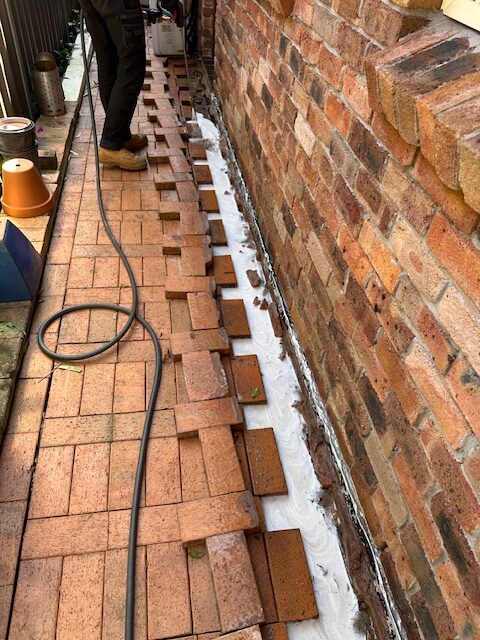Landscaping is essential for enhancing the visual appeal and market value of your home. However, if not executed with precision, landscaping can inadvertently compromise the integrity of your Termite barriers. These protective systems are vital in defending your property against damaging termite infestations, which can lead to severe structural issues. Certain landscaping practices and maintenance routines can disrupt these barriers, diminishing their effectiveness and exposing your home to potential risks. This comprehensive guide is crafted to equip you with the crucial information needed to make informed landscaping decisions that not only protect against termites but also maintain the functionality of your protective barriers.
Understand the Critical Role of Termite Barriers in Protecting Your Home
Termite barriers are specialized protective measures, which can be either physical or chemical, designed to be installed around or beneath your home to prevent termite infiltration. It is essential for every residence to have a reliable termite management system in place; therefore, understanding the specific type of barrier utilized in your property is crucial. A simple way to confirm this information is by checking your electrical meter box, which often contains important details regarding your termite protection. These barriers are particularly critical in safeguarding structures located in regions like Sydney’s Hills District, where termite activity is significantly high, posing serious threats to homeowners. By understanding how these barriers operate, you can take proactive steps to ensure your property remains safe from expensive termite damage.
- Physical Barriers: These barriers are typically constructed from durable materials such as stainless steel mesh or graded stones. They are installed beneath a building to effectively block termites from tunneling through and gaining access to your home.
- Chemical Barriers: These consist of liquid termiticides that are applied to the soil surrounding a structure, creating a treated zone that deters or eliminates termites from entering, thereby significantly enhancing the protective measures in place.

Identify Landscaping Practices That Threaten Your Termite Barriers
Many common landscaping practices can inadvertently damage or undermine the effectiveness of your termite barriers, thereby increasing the risk of infestations. Being aware of these practices empowers you to make informed decisions that will help safeguard your property against potential threats.
1. Planting Too Close to Your Home’s Foundation
When plants, shrubs, or trees are located too near your house, they can cause a variety of complications that jeopardize your termite defenses:
- Roots may penetrate physical barriers or disturb the treated soil in chemical barriers, ultimately reducing their protective capabilities.
- Dense vegetation can retain excess moisture around the foundation, which is a significant attractant for termites, thus increasing the risk of an infestation.
2. Adding Soil or Mulch Near the Foundation
Placing additional soil or mulch close to your home’s foundation can create a bridge over chemical barriers, allowing termites to bypass the protective measures in place. Organic mulch, in particular, can provide both a food source and habitat for termites, making it an appealing option for these pests and thus increasing the likelihood of an infestation.
3. Hardscaping and Paving Projects
The installation of paving stones, patios, or retaining walls close to your property can disrupt existing termite barriers. Soil movement during these construction projects can compromise the chemical seal or create gaps in physical barriers, resulting in vulnerabilities that termites could exploit, leading to potential infestations.
4. Considerations for Irrigation Systems
Poorly designed irrigation systems or excessive watering can saturate the soil around your home’s foundation. This not only reduces the effectiveness of any termiticides in chemical barriers but also creates a favorable environment for termite colonies, allowing them to thrive and potentially invade your home.

Adopt Effective Landscaping Strategies to Safeguard Your Termite Barriers
1. Ensure Adequate Clearance from Your Home
- It is advisable to maintain a distance of at least 50 cm between plants and trees and your home’s foundation, ensuring a robust barrier against termite access.
- Consider selecting smaller, non-invasive plant species that are less likely to develop extensive root systems capable of interfering with your termite barriers, thus enhancing the protective measures around your home.
2. Choose Termite-Resistant Mulch Options
- Opt for inorganic mulches such as gravel or stone, or consider utilizing termite-resistant materials like cedar or cypress to significantly reduce risks associated with termite attraction.
- Limit mulch piles to a maximum height of 5 cm, ensuring they are maintained at least 15 cm away from the foundation to effectively minimize moisture retention that could attract termites.
3. Avoid Disturbing Barriers During Landscaping Activities
- Before digging or installing landscaping features near your home, it is crucial to consult with a professional to avoid disturbing the integrity of the termite barriers or any termite baiting systems, thus ensuring continued protection.
- In the event of soil alterations, it is advisable to have the barrier reinspected and potentially retreated to ensure ongoing protection against termite invasion and to maintain the effectiveness of your defenses.
4. Thoughtful Landscape Design Considerations
- Strategically position irrigation systems away from the foundation to prevent moisture accumulation that could compromise the barrier and create a favorable environment for termites.
- Install root barriers for larger trees to prevent roots from encroaching on the termite barrier and causing potential damage, thus enhancing your property’s defenses.
- Exercise caution around termite reticulation pipes to avoid damaging them during landscaping activities, which could jeopardize your property’s defenses against infestations.
Immediate Actions to Take if Your Termite Barrier Is Compromised
If your landscaping efforts or natural occurrences have disrupted your termite barrier, taking swift action is crucial to prevent potential infestations:
- Schedule a Professional Inspection: A thorough termite inspection will help identify any vulnerabilities and confirm whether termites have breached your protective barrier, enabling you to take timely action.
- Reinforce Your Barrier: Based on the inspection findings, physical barriers may need repairs, while chemical barriers might require retreatment or a top-up to restore their effectiveness against termites and ensure your home remains protected.
- Implement Regular Monitoring: Routine inspections for termite activity are essential to ensure that your barrier remains intact and your property continues to be safeguarded from potential infestations.
Creative Landscaping Solutions to Boost Your Termite Protection
With careful planning and strategic design, your landscaping can effectively complement your termite protection efforts, creating a harmonious balance between beauty and safety:
- Incorporate gravel paths or decorative stones along the foundation to establish a dry zone that deters termites from approaching, thereby enhancing your property’s defenses.
- Utilize raised garden beds with adequate clearance from the house to minimize moisture retention near the foundation, further reducing the risk of termite attraction.
- Regularly trim vegetation to ensure proper ventilation and minimize moisture buildup, creating an inhospitable environment for termites and protecting your home.

Landscaping can be thoughtfully designed to enhance, rather than undermine, your termite barriers. By gaining a comprehensive understanding of how various yard designs impact termite protection, you can create a visually appealing and pest-free home environment. For expert termite advice or assistance with maintaining your barriers, reach out to our experienced team today. Let us collaborate to secure your home while you create the landscape of your dreams.
The Article: Termite Barriers for Effective Landscaping Solutions first appeared on https://writebuff.com.
References:
Termite Barriers for Effective Landscaping Solutions




You’ve touched on a critical aspect of home care that often gets overlooked. It’s interesting how the pursuit of a beautiful landscape can sometimes conflict with the underlying protective needs of a home, especially concerning termite barriers. I’ve experienced this firsthand when a landscaping project I undertook unintentionally disturbed the foundation treatment around my property. For those not aware, it can be incredibly easy to let aesthetics overshadow structural integrity.
Your experience resonates deeply. It’s fascinating how landscaping, which usually brings joy and beauty, can unintentionally put a home’s structural integrity at risk. The balance between creating an inviting outdoor space and protecting the foundation often requires a thoughtful approach.
You’ve hit the nail on the head, and I’m not just talking about landscaping tools. It’s a bit like trying to make your home look like a Pinterest board while forgetting that the house has to stay standing in the first place. I mean, who doesn’t want a yard that could rival a botanical garden? However, there’s that pesky little detail of termite barriers lurking in the background, just asking to be ignored.
You’re spot on with that observation. It’s easy to get swept away by the visuals of a perfect outdoor space while overlooking the underlying structures that really keep it all intact. Having a yard that looks like something out of a botanical garden is definitely a goal for many, but you’re right about the importance of those “pesky little details” like termite barriers.
You’ve really hit on a key point that resonates with many homeowners who are trying to balance beauty and safety in their spaces. The allure of a well-designed landscape can easily distract us from the crucial aspects of home care that protect our investment. I can relate to your experience with landscaping disrupting the foundation treatment. It’s surprising how a few missteps can lead to larger problems down the road, especially with something as insidious as termites lurking beneath the surface.
You’ve really touched on something that often gets overlooked. I think many homeowners become so excited about creating that perfect outdoor oasis that we can sometimes ignore the underlying issues that need attention first. It’s interesting how landscaping can almost feel like this rewarding, creative project, but it does require a bit of caution.
I see you’re on point about finding that balance; I recently came across an article that dives into effective landscaping solutions to keep those sneaky termites at bay while preserving the beauty of our homes.
‘Termite Barriers: Key Solutions for Effective Landscaping’
https://www.handymanbayside.com.au/termite-barriers-key-solutions-for-effective-landscaping/.
You raise a really good point about the balance between making a space look nice and keeping it safe. It’s too easy to get swept up in the excitement of a new landscaping project and forget about the foundation. I can imagine how frustrating that was for you when your work disturbed the termite barriers.
Your insights on the relationship between landscaping and termite barriers really highlight an often overlooked aspect of home maintenance. It’s so easy to get caught up in creating a beautiful outdoor space that we forget about the underlying protections like termite barriers. I’ve seen friends invest heavily in their gardens only to later discover that their landscaping choices compromised their home’s defenses.
You raise a crucial point about the balance between aesthetics and protection in our outdoor spaces. When we think about landscaping, the focus often leans heavily toward visual appeal, and it’s easy to overlook elements that play such an essential role in safeguarding our homes from pests like termites.
You’ve touched on something really significant with your comment. It’s fascinating how the desire to create a stunning outdoor environment can sometimes overshadow those essential protective measures we need for our homes. I’ve seen similar situations with friends who’ve really gone all out to make their gardens lush and inviting, only to later confront issues that could have been easily avoided with a little more thought about the underlying infrastructure, like termite barriers.
You’ve highlighted a crucial point that often gets lost in the excitement of creating that perfect outdoor retreat. It’s so easy to get caught up in the aesthetics of gardening—the vibrant flowers, the lush greenery, and the inviting seating areas. But as you pointed out, without a solid foundation, those beautiful spaces can quickly turn into a breeding ground for problems.
You’ve touched on a vital point that many overlook. The balance between aesthetics and functionality in landscaping is so delicate. It’s easy to focus on how a garden looks, but those choices can have real impacts on home maintenance and durability. I’ve seen cases where a beautiful landscape, with dense plantings too close to the foundation, became a haven for pests. Educating ourselves on the interplay between our gardens and home defenses can help us avoid these pitfalls.
Totally get what you’re saying. It’s a real balancing act, isn’t it? We all want a stunning outdoor space that feels like a retreat, but it’s easy to lose sight of what’s going on underneath. One thing I’ve learned is that a little planning can go a long way.
Your insights on the intersection of landscaping and termite barrier integrity resonate deeply with me, especially as someone who has navigated the complexities of maintaining a beautiful outdoor space while also prioritizing home protection. It’s interesting how landscaping is often viewed solely through the aesthetic lens, yet as you’ve highlighted, without a thorough understanding of its potential impact on termite barriers, homeowners may inadvertently expose themselves to significant risks.
It’s intriguing to think about how landscaping can both enhance our homes and potentially undermine the very safeguards we put in place to protect them. I’ve seen firsthand how a beautifully designed garden can transform a property, but I’ve also heard horror stories from friends who faced termite issues after neglecting their barriers while planting. It really highlights the importance of balance in our home care – we want our spaces to be inviting, yet we must also be vigilant about the underlying structures that keep our homes safe.